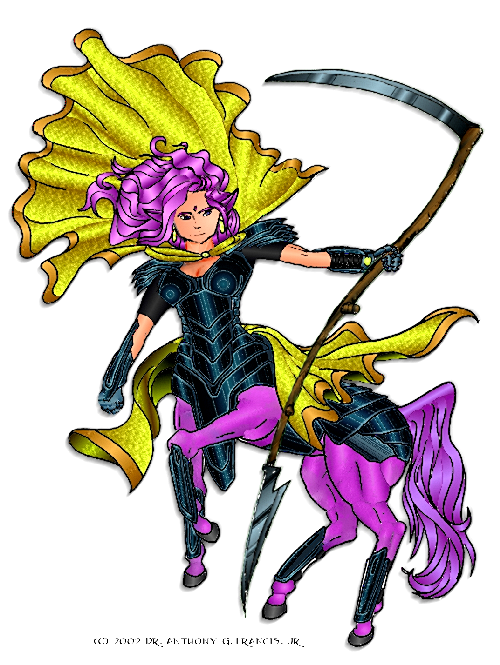The Centaur Compendium

What Are Centaurs?
cen.taur \'sen-.to.(*)r\ n [ME, fr. L Centaurus, fr. Gk Kentauros] 1: one of a race fabled to be half man and half horse and to dwell in the mountains of Thessaly.
A centaur is a mythical creature with the head and torso of a man joined to the body of a horse. With its origins in Greek mythology, the centaur is one of the most enduring mythological creations, persisting through art and literature in the Middle Ages and enjoying a rebirth with the twentieth century explosion in the genre of fantasy. This page is a collection of information about the centaur in art, literature and imagination - as well as the centaur on the Internet. I update it only rarely, so it is quite behind the times - no mention of Harry Potter, other than this one.
The History of the Myth
The centaur probably began as a horse totem of a tribe of early Greeks in prehistory. The earliest drawings of hippocentaurs (a kind of demon given human form, or kallikantzaroi, in ancient Greek myth) show men wearing fetishes of hindquarters of horses joined to their waists. These hobby-horse fetishes, common (in varying form) to European crop and fertility rituals, only later became depictions of human torsos joined to actual horse bodies. The hypothesis that the centaur represents a terrified tribal reinterpretation of a horse and rider is probably without merit.
The Greek love for the horse led to the ennoblement of the centaur in myth and legend (the only version of the kallikantzaroi to be so honored). The Centaur Chiron was known for his wisdom and healing abilities. Other centaurs did not fare so well in myth: Nessus was killed by Hercules for trying to rape (variously) his wife or a woman under his charge, and other centaurs were renowned for their weakness for drink. The centauromachy - the depiction of one or more of the fights between humans and centaurs in myth - became a popular feature of Greek art. The centaur was also used by some writers to symbolize man's dual nature as an intellectual creature (the human half) which was also an physical animal (the horse half).
In the Medieval period, the centaur fared more poorly, often becoming a demonic image. Nevertheless, the centaur remained a popular character in art, no doubt due to the vast influence of Greek art and literature on Western culture.
The Centaur in Modern Times
In modern times, the centaur has reappeared in art and literature, especially in the genre of fantasy. C.S. Lewis' The Narnian Chronicles and Piers Anthony's Xanth series have prominent centaur characters. Science fiction has used the character as well; John Varley's Titan, Wizard, Demon series, Jack Chalker's Wellworld series, Walter Jon William's Knight Moves, Elf Sternberg's The Journal Entries series, and my own (as yet unpublished, gripe, gripe) homo centauris all feature prominent centaur characters.
Centaur Links
Staggeringly out of date. I mean, gopher? Who uses gopher?Centaur Pages and Images
- unofficial Xanth page:Feb-10-95(v3.1)
- Donna Barr's Stinz
- Donna Barr's Stinz in "Bob War."
- ANU Art History (including two centaur images)
General Science-Fiction and Fantasy Links
- The Lysator Science Fiction & Fantasy Archive
- Other Science Fiction and Fantasy Links
- Science Fiction and Fantasy FTP Sites Maintained By sauron@wpi.edu
Anthropomorphic Links
- gopher://twinbrook.cis.uab.edu:70/1A/adrawing.70
- Furry List:Fanzines, Etc. A-L
- [alt.fan.furry] Incomplete Listing of Zoomorphic Publications
- Horse Country
Mythology and Other Literature
Other Centaur-Related Art
- ANU Art History Top Level Menu Page
- Art Cellar Exchange Classified Ads
- unci's list of active artists
- Art Gates

 By day, Anthony Francis
makes computers smarter; by night he writes science fiction and draws
comic books. He lives in San Jose with his wife and cats but his heart
will always belong in Atlanta.
By day, Anthony Francis
makes computers smarter; by night he writes science fiction and draws
comic books. He lives in San Jose with his wife and cats but his heart
will always belong in Atlanta.